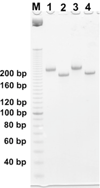Blunt-ended DNA stacking interactions in a 3-helix motif
- PMID: 20532374
- PMCID: PMC3454654
- DOI: 10.1039/c0cc01167c
Blunt-ended DNA stacking interactions in a 3-helix motif
Abstract
We demonstrate that intermolecular stacking is capable of forming one-dimensional arrays of a blunt-ended 3-helix DNA motif. The array can be visualized in the atomic force microscopy through conjugated streptavidin nanoparticles. We estimate the strength of the triple stacking interaction to be -8.6 kcal mol(-1).
Figures




Similar articles
-
DNA-templated self-assembly of protein and nanoparticle linear arrays.J Am Chem Soc. 2004 Jan 21;126(2):418-9. doi: 10.1021/ja0383367. J Am Chem Soc. 2004. PMID: 14719910
-
Analysis of various sequence-specific triplexes by electron and atomic force microscopies.Biophys J. 1998 Feb;74(2 Pt 1):1015-23. doi: 10.1016/S0006-3495(98)74026-3. Biophys J. 1998. PMID: 9533714 Free PMC article.
-
Long-Range Ordering of Blunt-Ended DNA Tiles on Supported Lipid Bilayers.J Am Chem Soc. 2017 Aug 30;139(34):12027-12034. doi: 10.1021/jacs.7b06572. Epub 2017 Aug 21. J Am Chem Soc. 2017. PMID: 28783358
-
Stabilities of double- and triple-strand helical nucleic acids.Prog Biophys Mol Biol. 1992;58(3):225-57. doi: 10.1016/0079-6107(92)90007-s. Prog Biophys Mol Biol. 1992. PMID: 1380719 Review.
-
Surface biology of DNA by atomic force microscopy.Annu Rev Phys Chem. 2001;52:71-92. doi: 10.1146/annurev.physchem.52.1.71. Annu Rev Phys Chem. 2001. PMID: 11326059 Review.
Cited by
-
Free energy analysis and mechanism of base pair stacking in nicked DNA.Nucleic Acids Res. 2016 Sep 6;44(15):7100-8. doi: 10.1093/nar/gkw607. Epub 2016 Jul 12. Nucleic Acids Res. 2016. PMID: 27407106 Free PMC article.
-
Concepts and Application of DNA Origami and DNA Self-Assembly: A Systematic Review.Appl Bionics Biomech. 2021 Nov 16;2021:9112407. doi: 10.1155/2021/9112407. eCollection 2021. Appl Bionics Biomech. 2021. PMID: 34824603 Free PMC article. Review.
-
High-throughput single-molecule quantification of individual base stacking energies in nucleic acids.Nat Commun. 2023 Feb 6;14(1):631. doi: 10.1038/s41467-023-36373-8. Nat Commun. 2023. PMID: 36746949 Free PMC article.
-
Reversible Covalent Stabilization of Stacking Contacts in DNA Assemblies.Angew Chem Int Ed Engl. 2019 Feb 25;58(9):2680-2684. doi: 10.1002/anie.201812463. Epub 2019 Jan 29. Angew Chem Int Ed Engl. 2019. PMID: 30694591 Free PMC article.
-
Molecular ping-pong Game of Life on a two-dimensional DNA origami array.Philos Trans A Math Phys Eng Sci. 2015 Jul 28;373(2046):20140215. doi: 10.1098/rsta.2014.0215. Philos Trans A Math Phys Eng Sci. 2015. PMID: 26078341 Free PMC article.
References
Publication types
MeSH terms
Substances
Grants and funding
LinkOut - more resources
Full Text Sources

